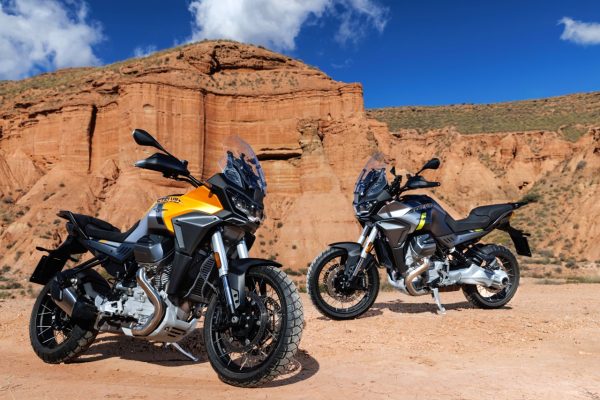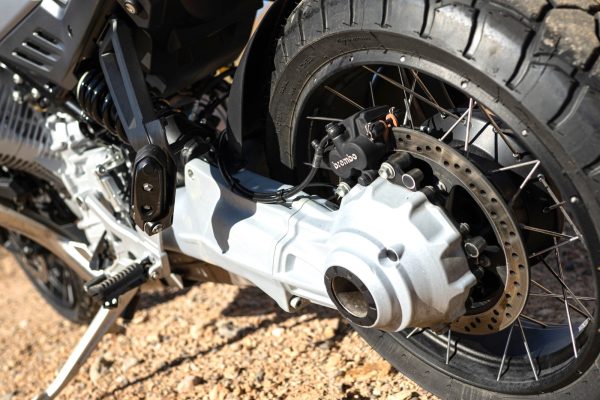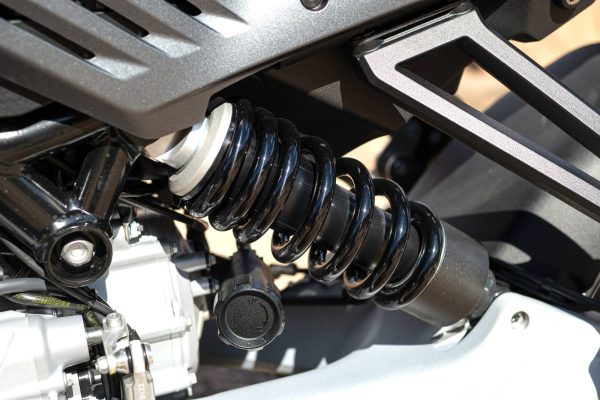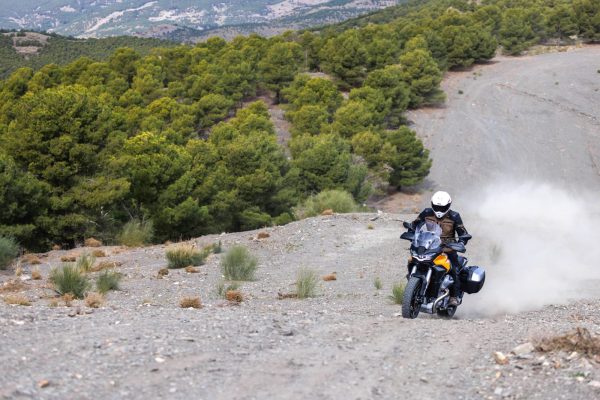Moto Guzzi is represented in the adventure bike segment by the Stelvio, the second model of the modern era as a touring machine with light off-road attributes. Can it hold its own against the Multistrada, Africa Twin, Tiger and Co? There are big expectations for the new Moto Guzzi Stelvio.
Around 20 years after the relaunch and takeover by Aprilia, the company presented the new Mandello V100 with a completely new, water-cooled 90-degree twin-cylinder engine for its centenary in autumn 2022. A quantum leap for Moto Guzzi, the bike was well made and displayed high-quality components. A year and a half has now passed and the Stelvio is on the market.
The machine looks beefy and massive and concentrates the volume in the front section between the petrol tank and fairing. Despite the exposed cylinder heads, the front view is still relatively compact.

The water-cooled 90 degree V2 “Compact Block” engine is the same as on the predecessor model and draws the same power from 1,042cc with 115hp at 8,700rpm, 105Nm at 6,750rpm, the rev limit is 9,500rpm. The Guzzi-typical tilting of the engine with longitudinal crankshaft is absorbed by a balancer shaft and the wet clutch on the rear of the gearbox is now accessible without having to open the engine. The powertrain is a dry sump and a new oil pan was designed for more ground clearance. To shorten the length, the alternator runs at the front of the engine.
A revolution is the vertical instead of horizontal gas flow through the cylinder heads for more power, torque and better emissions. Two chain-driven, overhead camshafts per cylinder control the gas exchange of the engine, which is equipped with a ride-by-wire system. The V100 Mandello’s gearbox attracted attention at first with rather harsh shifting into first. To improve the transmission, the torque damper was relocated from the clutch shaft to the clutch basket, and the shift drum redesigned.
The mounting of the rear swingarm directly in the gearbox housing remains unchanged, but has been reinforced, as has the single-sided swingarm, whose thickness has been increased from 5mm to 7mm to withstand greater loads caused by a fully loaded ADV bike off-road.
The trellis tube main frame has been reinforced in the steering head area and the engine is now fixed to the front outriggers with two additional bolts. The new flagship model relies on an upside-down 46mm ZF fork with 170mm travel, with adjustable rebound and spring preload. At the rear is a single KYB shock without a linkage system, rebound and spring preload is adjustable. A new petrol tank with a capacity of 21 litres moves the rider around 30-40 mm to the rear, which is why the aluminium handlebars are bent backwards for a comfortable seating position.
The Rider Assistance Solution from PFF (Piaggio Fast Forward) celebrates its première in the Stelvio. This is an optional extra based on Imaging Radar 4D and is supposed to offer better resolution than previous systems. The sensors are located above the headlights and under the rear seat and provide the input for cruise control, front collision warning, rear blind spot and lane change assist. There is also Cornering ABS System from Continental.

Riding modes Turismo, Rain, Strada, Sport, Off Road are available, each can be personalised with different preferences. Traction control can be switched off in all modes, but ABS can be eliminated on both wheels only in off-road mode. It is not possible to change these settings while riding.
The lighting system with cornering lights is fully equipped with LEDs, and there is a USB socket next to the 5-inch TFT display. With the Moto Guzzi MIA multimedia platform, the smartphone can be connected via Bluetooth.
The Stelvio has tubeless spoked wheels in 19/17 inches, as is standard for the class and Michelin Anakee tyres were mounted at the presentation. With a dry weight of around 230kg it’s slowed down by Brembo brakes with twin 320mm discs at the front and one 280mm disc at the rear.
The seat is pleasantly low and narrow, riders over 170 cm tall can easily get both feet on the ground. The modification to the drivetrain with the new torsion damper in the clutch basket has not been able to eliminate the hard shifting when engaging first. Therefore apply the brakes before downshifting from neutral so that the Stelvio does not leap forwards! Otherwise, the gearbox and the quickshifter work fine and the gear ratios are well balanced.
The Stelvio threads its way flawlessly into bends, with little effort the machine can be coaxed precisely onto the right line. That’s when you enjoy the absence of the engine’s backlash and the almost reaction-free shaft drive. Load changes leave this ADV bike completely unimpressed, and the fork also resists braking with decent progression. Everything feels fine for a brisk ride on the road, it is no exaggeration to say that the Stelvio is probably the best Moto Guzzi for road use of all times.

When the rhythm becomes sporty, the set-back riding position makes you feel a little far away from the front, making it difficult to build up a relationship with the front tyre. As the roads in Andalusia were of excellent quality with perfect grip, we were able to sit back and relax and just let the Guzzi do its job as a comfortable touring bike. The shock absorber was a little on the soft side, so the footrests occasionally touched the tarmac in turns. This could certainly be improved with more spring preload and a slightly raised rear end, which could also change the feel of the front wheel.
The 19 inch front wheel and the narrower rear tyre (170/60 instead of 190/55) give the Stelvio a better precision and astonishing handling, allowing the Michelin Anakee tyres to display the best of their qualities.
The engine is great fun on the road and quickly gains speed without vibration or excessive noise. From around 2000rpm in top gear, the throttle can be opened up and the V2 revs smoothly up to the limiter at almost 10,000 rpm. A little more torque would be desirable at the very bottom of the range but significant propulsion is noticeable from around 4-5,000rpm. There were hardly any differences in the power delivery between Turismo and Strada modes, in the Sport setting slightly more throttle response is noticeable, Rain was not tested under the given conditions.
We were only able to ride briefly offroad for photo purposes, where the set-back position of the rider’s seat and footrests became noticeable once again, especially with panniers. The front wheel becomes quite light under acceleration. The Stelvio doesn’t really want to romp around off-road, the 170mm suspension travel front and rear and ground clearance are a little sparse. Instead, the new entry simply wants to be a comfortable touring bike that sets new references for Moto Guzzi in terms of comfort, chassis and powertrain.
The windscreen can be adjusted electrically by 70mm up to 150km/h. The difference is noticeable, the helmet and upper body remain well protected while the shoulders remain exposed to the wind. The support of the windscreen on the two trailing arms is a little weak and tends to rattle over small bumps.
Vibrations are insignificant thanks to thick rubber pads on the footrests. The end of the gear lever can be adjusted, but the lever itself is positioned too low for comfortable operation with boots. The heel protectors on the footrests are a little too short and the movement of the swingarm can be clearly felt on the left side. There is plenty of space for the rider and passenger, with robust grab handles on the seat, which is positioned higher than that of the rider.
The three basic functions of the Advanced Rider Assistance Systems (ARAS) which can be added as an option are Lane Change Assist (LCA), Forward Collision Warning (FCW), and the Blind Spot Information System (BLIS). The adaptive cruise control FCC (Following Cruise Control), acts on the engine brake by increasing it when the vehicle in front slows down.

Conclusion
The Moto Guzzi Stelvio as the second model with the new engine brings numerous improvements. Despite its adventure bike appearance, off-road excursions are not its favourite playground, ergonomics and suspension elements are more suited to long road tours, where it can shine thanks to a well-balanced chassis, the distinctive engine and the excellently tuned electronic assistance systems. The Stelvio is an interesting addition to the market of touring ADV bikes such as the Suzuki V-Strom 1050, Triumph Tiger 900, Ducati Multistrada and Honda Africa Twin, where it is the only one with a maintenance-free shaft drive.
MOTO GUZZI STELVIO
ENGINE
Type Four-stroke 90° V2 engine DOHC four valves per cylinder
Displacement 1042 cm³
Bore & Stroke 96mm x 72 mm
Cooling Liquid-cooled XXXXXXXXXX
Compression ratio 12.6:1
Fuel metering EFI 52mm throttle bodies ride-by-wire management
Tank capacity 21 litres (3.5 litres reserve)
Transmission 6-speed
Clutch Multi-disc clutch in oil bath with hydraulic actuation
DIMENSIONS
Wheelbase 1520 mm
Seat height 830 mm
Ground clearance NA
Claimed Weight 246kg (wet)
SUSPENSION
FRONT 46mm ZF USD fork, 170mm travel adjustable preload and rebound damping
REAR KYB single shock, no linkage, adjustable preload and rebound damping, 170mm travel
BRAKES
Front 320mm disc, Brembo four-piston radial brake calipers
Rear 280mm disc, Brembo twin-piston floating calliper
RUNNING GEAR
Handlebar NA
Front tyre 120/70 – R19″ tubeless radial tyre
Rear tyre 170/60 – R17″ tubeless radial
PRICE & CONTACTS
RRP To be confirmed
BROWSER www.motoguzzi.com/au
WORDS & PHOTOS || KLAUS NENNEWITZ